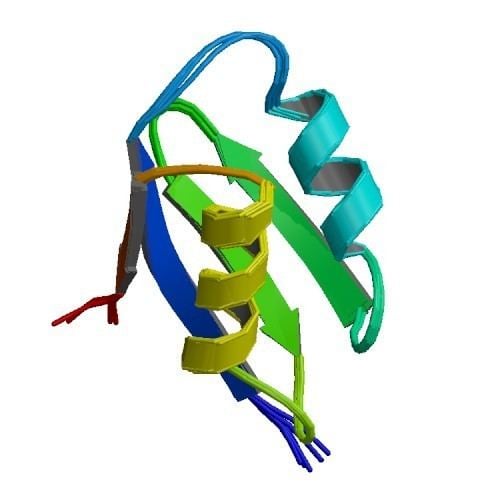Specialty endocrinology ICD-9-CM 759.89 OMIM 309400 | ICD-10 E83.0 ICD-O ? DiseasesDB 8029 | |
 | ||
Menkes disease (MNK), also known as Menkes syndrome, is an X-linked recessive disorder that affects copper levels in the body, leading to copper deficiency. The onset of Menkes disease typically begins during infancy, affecting about 1 in 100,000 to 250,000 newborns. Infants with MNK syndrome often do not live past the age of 3. It is more common in males than females, because it only takes one copy of the X-linked recessive gene to be expressed for a male to develop the disease. In order for females to develop the disorder they would need to express two copies of the gene, one on each X chromosome to develop the disorder. MNK is characterized by kinky hair, growth failure, and deterioration of the nervous system. It is caused by mutations in the copper transport gene, ATP7A, which is responsible for making a protein that is important for regulating the copper levels in the body.
Contents
The disorder was originally described by John Hans Menkes (1928–2008) et al. in 1962.
Alternative names:
Signs and symptoms
Signs and symptoms of this disorder include weak muscle tone (hypotonia), sagging facial features, seizures, intellectual disability, and developmental delay. The patients have brittle hair and metaphyseal widening. In rare cases, symptoms begin later in childhood and are less severe. Affected infants may be born prematurely. Symptoms appear during infancy and are largely a result of abnormal intestinal copper absorption with a secondary deficiency in copper-dependent mitochondrial enzymes. Normal or slightly slowed development may proceed for 2 to 3 months, and then there will be severe developmental delay and a loss of early developmental skills. Menkes Disease is also characterized by seizures, failure to thrive, subnormal body temperature, and strikingly peculiar hair, which is kinky, colorless or steel-colored, and easily broken. There can be extensive neurodegeneration in the gray matter of the brain. Arteries in the brain can also be twisted with frayed and split inner walls. This can lead to rupture or blockage of the arteries. Weakened bones (osteoporosis) may result in fractures.
Occipital horn syndrome (sometimes called X-linked cutis laxa or Ehlers-Danlos type 9) is a mild form of Menkes syndrome that begins in early to middle childhood. It is characterized by calcium deposits in a bone at the base of the skull (occipital bone), coarse hair, loose skin, and joints.
Mechanism
The ATP7A gene encodes a transmembrane protein that transport copper across the cell membranes. It is found throughout the body, except for the liver. In the small intestines, the ATP7A protein helps control the absorption of copper from food. In other cells, the protein travels between the Golgi apparatus and the cell membrane to maintain copper concentrations in the cell. The protein is normally found in the Golgi apparatus, which is important for modifying proteins, including enzymes. In the Golgi apparatus, ATP7A protein provides copper to certain enzymes that are critical for the structure and function of bone, skin, hair, blood vessels, and the nervous system. One of the enzymes, lysyl oxidase, requires copper for proper function. This enzyme cross-links tropocollagen into strong collagen fibrils. The defective collagen contributes to many of the aforementioned connective tissue manifestations of this disease. If copper levels become excessive, the protein will travel to the cell membrane and eliminate excess copper from the cell. Mutations in the ATP7A gene such as deletions and insertions lead to parts of the gene being deleted, resulting in a shortened ATP7A protein. This prevents the production of a functional ATP7A protein, leading to the impaired absorption of copper from food and copper will not be supplied to certain enzymes.
Cause & Prevention
Mutations in the ATP7A gene, located on chromosome Xq21.1, leads to Menkes syndrome. This condition is inherited in an X-linked recessive pattern. About 30% of MNK cases are due to new mutations and 70% are inherited, almost always from the mother. Even though the disease is more common in males, females can still be a carrier of the disease. As the result of a mutation in the ATP7A gene, copper is poorly distributed to cells in the body. Copper accumulates in some tissues, such as the small intestine and kidneys, while the brain and other tissues have unusually low levels. The decreased supply of copper can reduce the activity of numerous copper-containing enzymes that are necessary for the structure and function of bone, skin, hair, blood vessels and the nervous system such as lysyl oxidase. As with other X-linked disorders, female children of a carrier mother have an even chance of carrying the disorder, but are normally well; male children have an even chance of having the disorder or of being free from it. A genetic counselor may have useful advice.
Diagnosis
Menkes syndrome can be diagnosed by blood tests of the copper and ceruloplasmin levels, skin biopsy, and optical microscopic examination of the hair to view characteristic Menkes abnormalities. X-rays of the skull and skeleton are conducted to look for abnormalities in bone formation. Urine homovanillic acid/vanillylmandelic acid ratio has been proposed as a screening tool to support earlier detection. Since 70% of MNK cases are inherited, genetic testing of the mother can be performed to search for a mutation in the ATP7A gene.
Treatment and Prognosis
There is no cure for Menkes disease. Early treatment with injections of copper supplements (in the form of acetate salts) may be of some slight benefit. Among 12 newborns who were diagnosed with MNK, 92% were alive at age 4.6. Other treatment is symptomatic and supportive. Treatments to help relieve some of the symptoms includes, pain medication, anti-seizure medication, feeding tube when necessary, and physical and occupational therapy.
Epidemiology
One European study reported a rate of 1 in 254,000; a Japanese study reported a rate of 1 in 357,143. No correlation with other inherited characteristics, or with ethnic origin, is known.
